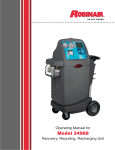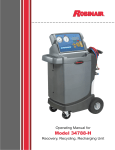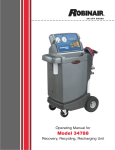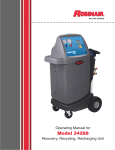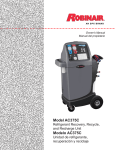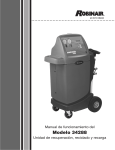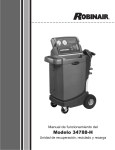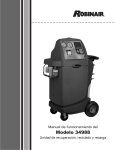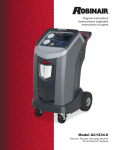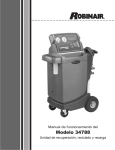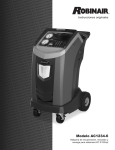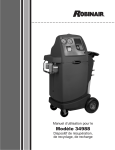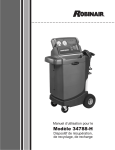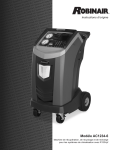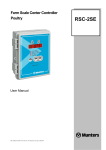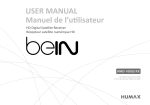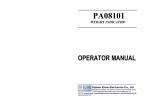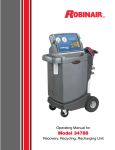Download User Manual
Transcript
Operating Manual for Model 34988 Recovery, Recycling, Recharging Unit Model 34988 Recovery, Recycling, & Recharging Unit SAFETY DEFINITIONS: Follow all WARNING, CAUTION, and NOTE messages in this manual. These messages are defined as follows: WARNING means you may risk serious personal injury or death; CAUTION means you may risk personal injury, property damage, or unit damage; and NOTEs and OPERATING TIPS provide clarity and helpful information. These safety messages cover situations ROBINAIR is aware of. ROBINAIR cannot know, evaluate, and advise you as to all possible hazards. You must verify that conditions and procedures do not jeopardize your personal safety. DISCLAIMER: Information, illustrations, and specifications contained in this manual are based on the latest information available at the time of publication. The right is reserved to make changes at any time without obligation to notify any person or organization of such revisions or changes. Further, ROBINAIR shall not be liable for errors contained herein or for incidental or consequential damages (including lost profits) in connection with the furnishing, performance, or use of this material. If necessary, obtain additional health and safety information from the appropriate government agencies and the vehicle, refrigerant, and lubricant manufacturers. WARNINGS ALLOW ONLY QUALIFIED PERSONNEL TO OPERATE THE UNIT. Before operating the unit, read and follow the instructions and warnings in this manual. The operator must be familiar with air conditioning and refrigeration systems, refrigerants, and the dangers of pressurized components. If the operator cannot read this manual, operating instructions and safety precautions must be read and discussed in the operator’s native language. PRESSURIZED TANK CONTAINS LIQUID REFRIGERANT. Do not overfill the internal storage vessel, because overfilling may cause explosion and personal injury or death. Do not recover refrigerants into nonrefillable containers; use only federally authorized refillable containers (DOT spec. 4BW or 4BA). HOSES MAY CONTAIN LIQUID REFRIGERANT UNDER PRESSURE. Contact with refrigerant may cause personal injury. Wear protective equipment, including safety goggles. Disconnect hoses using extreme caution. AVOID BREATHING A/C REFRIGERANT AND LUBRICANT VAPOR OR MIST. Exposure may irritate eyes, nose, and throat. To remove refrigerant from the A/C system, use only equipment certified for the type of refrigerant being removed. Use the unit in locations with mechanical ventilation that provides at least four air changes per hour. If accidental system discharge occurs, ventilate the work area before resuming service. DO NOT USE AN EXTENSION CORD. An extension cord may overheat and cause fire. If you must use an extension cord, use the shortest possible cord with a minimum size of 14 AWG. TO REDUCE THE RISK OF FIRE, do not use the unit in the vicinity of spilled or open containers of gasoline or other flammable substances. CAUTION—DO NOT PRESSURE TEST OR LEAK TEST EQUIPMENT AND / OR VEHICLE AIR CONDITIONING SYSTEMS WITH COMPRESSED AIR. Some mixtures of air and refrigerant have been shown to be combustible at elevated pressures. These mixtures, if ignited, may cause injury or property damage. TO PREVENT CROSS-CONTAMINATION, USE THIS UNIT WITH R-134A REFRIGERANT ONLY. The unit is designed to recover, recycle, and recharge only R-134a refrigerant. Do not attempt to adapt the unit for another refrigerant. Do not mix refrigerant types through a system or in the same container; mixing of refrigerants will cause severe damage to the unit and the vehicle air conditioning system. HIGH VOLTAGE ELECTRICITY INSIDE THE UNIT HAS A RISK OF ELECTRICAL SHOCK. Exposure may cause personal injury. Disconnect the power before servicing the unit. Additional health and safety information may be obtained from the refrigerant and lubricant manufacturers. OPERATING NOTE: At temperatures exceeding 120° F / 49° C, wait 10 minutes between recovery jobs. Table of Contents Introduction Technical Specifications . . . . . . . . . . . . . . . . . . . . . . . . . . . . . . . . 2 Control Panel Functions . . . . . . . . . . . . . . . . . . . . . . . . . . . . . . . . 3 Glossary . . . . . . . . . . . . . . . . . . . . . . . . . . . . . . . . . . . . . . . . . . . . 3 Menu Functions . . . . . . . . . . . . . . . . . . . . . . . . . . . . . . . . . . . . . . . 4 Setup Unpack the Accessory Kit . . . . . . . . . . . . . . . . . . . . . . . . . . . . . . . 5 Assemble the Dye Bottle and Oil Bottles . . . . . . . . . . . . . . . . . . . . 5 Power Up the Unit . . . . . . . . . . . . . . . . . . . . . . . . . . . . . . . . . . . . . 6 Select a Language . . . . . . . . . . . . . . . . . . . . . . . . . . . . . . . . . . . . 6 Select Units . . . . . . . . . . . . . . . . . . . . . . . . . . . . . . . . . . . . . . . . . . 7 Set Date & Time . . . . . . . . . . . . . . . . . . . . . . . . . . . . . . . . . . . . . . 7 Adjust Tank Fill Default . . . . . . . . . . . . . . . . . . . . . . . . . . . . . . . . . 7 Maintain Vacuum Pump . . . . . . . . . . . . . . . . . . . . . . . . . . . . . . . . 7 Manual Tank Fill . . . . . . . . . . . . . . . . . . . . . . . . . . . . . . . . . . . . . . 8 Edit Print Header . . . . . . . . . . . . . . . . . . . . . . . . . . . . . . . . . . . . . . 9 Operating Instructions Recover Refrigerant from a Vehicle . . . . . . . . . . . . . . . . . . . . . . 10 Evacuate the A/C System . . . . . . . . . . . . . . . . . . . . . . . . . . . . . . 11 Flushing the Hoses . . . . . . . . . . . . . . . . . . . . . . . . . . . . . . . . . . . 12 Recharge the A/C System . . . . . . . . . . . . . . . . . . . . . . . . . . . . . . 13 Operating Instructions — Automatic . . . . . . . . . . . . . . . . . . . . . . 16 System Flush . . . . . . . . . . . . . . . . . . . . . . . . . . . . . . . . . . . . . . . . . . 17 Maintenance General . . . . . . . . . . . . . . . . . . . . . . . . . . . . . . . . . . . . . . . . . . . . 19 Electrical Protection . . . . . . . . . . . . . . . . . . . . . . . . . . . . . . . . . . . 19 Manually Fill the Internal Storage Vessel (ISV) . . . . . . . . . . . . . . 19 Tank Fill Hose Filter Service . . . . . . . . . . . . . . . . . . . . . . . . . . . . 20 Replace the Filter-Drier . . . . . . . . . . . . . . . . . . . . . . . . . . . . . . . . 21 Scale Calibration Check . . . . . . . . . . . . . . . . . . . . . . . . . . . . . . . 22 Change Vacuum Pump Oil . . . . . . . . . . . . . . . . . . . . . . . . . . . . . 23 Adjust Tank Fill Level . . . . . . . . . . . . . . . . . . . . . . . . . . . . . . . . . . 24 Check for Leaks . . . . . . . . . . . . . . . . . . . . . . . . . . . . . . . . . . . . . 24 Replace the Printer Paper . . . . . . . . . . . . . . . . . . . . . . . . . . . . . . 24 Edit Print Header . . . . . . . . . . . . . . . . . . . . . . . . . . . . . . . . . . . . . 25 Replacement Parts . . . . . . . . . . . . . . . . . . . . . . . . . . . . . . . . . . . 25 Spanish Manual . . . . . . . . . . . . . . . . . . . . . . . . . . . . . . . . . . . . . . . . 27 French Manual . . . . . . . . . . . . . . . . . . . . . . . . . . . . . . . . . . . . . . . . . 52 Safety Precautions . . . . . . . . . . . . . . . . . . . . . . . Inside Front Cover Warranty . . . . . . . . . . . . . . . . . . . . . . . . . . . . . . . . Inside Back Cover IMPORTANT: To comply with federal law governing A/C system service, you must complete and mail the MVAC Certification Form included in the accessory kit. Technicians using this equipment must be certified under EPA Section 609 (Environmental Protection Agency). For more information, read the MACS information included in the accessory kit, or visit the MACS website at www.macsw.org. To validate the warranty provided by Robinair, complete the warranty card included in the accessory kit, and mail it within ten days from the purchase date of the unit. 554228 Rev. E July 30, 2013 1 Introduction Robinair No. 34988 is used on R-134a vehicles and is designed to be compatible with existing service equipment and standard service procedures. Model No. 34988 is a UL-listed, singlepass system that meets SAE specifications for recycled refrigerant. Follow the SAE-J2211 recommended service procedure for the containment of R-134a. The unit includes a 1.5 cfm (42 l/m) Robinair high vacuum pump for fast, thorough evacuation. The compressor pulls the A/C system to 0 psig, then works in series with the vacuum pump to achieve highly efficient recovery and immediate recharge. If the system is not opened for service, there is no need to pull additional vacuum. If the system is opened for service, use the unit’s vacuum cycle to remove air and moisture from the A/C system. (We recommend a minimum 15-minute vacuum, or follow the vehicle manufacturer’s specs.) Note: R-134a systems require special oils. Refer to the A/C system manufacturer’s service manual for oil specifications. Alert: visual and audio notice that machine needs attention. Manifold Gauges: connect to vehicle A/C system; show system’s low-side and high-side pressure. Control Panel & Digital Display: interface between operator and machine. Database Expansion Slot: an optional database will supply information regarding charge capacity by vehicle model. Main Power Switch: supplies electrical power to unit. UV Dye Reservoir: holds UV dye to be injected into vehicle A/C system. Printer: produces printouts of vehicle diagnostics. Oil Drain Bottle: collects oil during a recovery sequence. Vacuum Pump Exhaust Oil Inject Reservoir: holds oil to be injected into vehicle A/C system. Technical Specifications Nominal Voltage . . . . . . . . . . 34988: 115V, 60 Hz . . . . . . . . . . . . . . . . . . . . 34988-I: 230V, 50/60 Hz Operating Range . . . . . . . 50° to 120° F (11° to 49° C) Utilization Voltage Range . . . 34988: . . . . . . . . . . . . . . . . . . . . 34988-I: Pump Free-Air Displacement . . . . . . 1.5 cfm (42 l/m) 2 104–127 200–250 Filter-Drier . . . . . . . . . . . . . . . . . 43 cu. in. spin-on type Dimensions . . . . . . . . . . . . . . . . 49" H x 34" W x 23" D . . . . . . . . . . . . . . . (124.5 cm x 86.4 cm x 58.4 cm) Introduction Control Panel Functions AUTOMATIC activates a menu that helps the user set up an automatic recover / vacuum / leak test / charge sequence. CHARGE activates the sequence that charges the vehicle A/C system with a programmed amount of refrigerant. EXIT returns test sequence to previous screen. HELP displays screens that explain information or steps to take. INJECT OIL injects oil into vehicle A/C system. Choose control panel functions by pressing the SELECT key that appears below the function on the display. Time Date Automatic Recover Vacuum Charge Next NEXT displays next screen in the sequence. NO answers a query. PAUSE temporarily stops the machine from running the current sequence. PRINT (when it appears on the control panel) produces a printout of screen content. Turning off the machine clears the print memory. RECOVER activates the sequence to recover refrigerant from the vehicle system. RESUME reactivates a paused sequence. SAVE stores the information loaded for future use by the program. START begins a function. STOP terminates a function. TOGGLE UNITS moves the cursor through choices on the screen. VACUUM activates the sequence that pulls a deep vacuum on the vehicle system to remove air and moisture. ARROWS are used for scrolling through menu items. CONTRAST lighter CONTRAST darker YES answers a query. Glossary A/C System : The vehicle air conditioning system being serviced. Internal Storage Vessel (ISV): The refillable refrigerant storage vessel designed specifically for this unit; 30 lb. (14 kg). Source Tank : A disposable tank of new refrigerant used to refill the ISV; not included. Unit : Model No. 34988. 554228 Rev. E July 30, 2013 3 Introduction Menu Functions Adjust Refill Default Refrigerant Management When connected to a refrigerant source, the unit maintains a pre-set amount of refrigerant in the internal storage vessel. This value may be adjusted up or down to suit the user’s needs. (The default is 15 lbs.). Displays the amount of refrigerant recovered, charged, and replenished (for the life of the unit), and filtered (since the last filter change). Refer to instructions outlined in the Maintenance section under Adjust Tank Fill Level. Displays the revision level of the relay board software in the unit. Calibration Check Use to verify internal scale calibration. Refer to instructions in Maintenance section under Scale Calibration Check. Display ISV Info Displays internal storage vessel (ISV) pressure and temperature. Use to check ISV for excessive pressure. Edit Print Header Program information that will appear on the printout each time the print function is used. Hose Flush Flushes residual oil from the unit to prepare for the service of next vehicle. Maintain Filter The filter-drier removes acid, particulates, and moisture from the refrigerant. To meet SAE J-2788 requirements, it is mandatory to replace the filter-drier after 150 lbs. (68 kg) of refrigerant has been filtered. This menu item shows how much refrigerant has been filtered since the last filter change, and displays the filter capacity remaining until the machine locks down and no longer functions. Refer to the instructions outlined in the Maintenance section under Replace the Filter-Drier. Maintain Vacuum Pump Displays how long the vacuum pump has operated since the last oil change, and the amount of time remaining until the next oil change is needed. For maximum vacuum pump performance, change vacuum pump oil after every 10 hours of operation. Refer to the instructions outlined in the Maintenance section under Change Vacuum Pump Oil. 4 Relay X.XXX Select Language Choose to have prompts displayed in one of three languages: English, French, or Spanish. English is the default language. Select Units Program the machine to display units of measure in pounds, kilograms, ounces, or grams. The default display is in pounds. Service Menu For Robinair service center use only. Set Date and Time Use the keypad to program the machine for the current date and time. Press “2” for AM and press “7” for PM. System Flush A method of removing oil by forcing liquid refrigerant through an A/C system or components. Tank Fill Transfer refrigerant from the source tank to the internal storage vessel (ISV). Refer to instructions outlined in the Maintenance section under Manually Fill the ISV. Version X.XXX Displays the revision level of the software in the unit. Setup Unpack the Accessory Kit Unpack the accessory kit from the box, and remove the plastic packaging. The kit consists of • A calibration weight. • Vacuum pump oil, oil filler cap, and tube. • Service hoses. • Four bottles—oil reservoir, oil drain, UV dye reservoir, spare reservoir. • Three rolls of paper for the printer. • Plastic pouch containing a warranty card (to be completed and mailed), applicable MSDS sheets, a service center listing, and an envelope of Mobile Air Conditioning Society (MACS) information. Important: To operate this equipment, the owner must complete and mail the MVAC Certification Form, and technicians must be certified with the Environmental Protection Agency (EPA). Assemble the Dye Bottle and Oil Bottles Oil Inject Bottle 1.Determine the correct oil for the A/C system being serviced. 2.Unscrew the lid from the oil inject reservoir and remove the piston. 3.Fill the reservoir with oil only to the MAX FILL line. Overfilling the reservoir will compromise the o-ring seal and may cause air to be injected into the vehicle system. 4.Spread a thin film of oil on the piston o-ring (to reduce seal drag), and insert the piston into the reservoir. Thread the lid onto the reservoir. 5.Slowly push the piston into the reservoir until you see oil at the connector. 6.Inspect the oil reservoir bottle to ensure there are no air bubbles between the piston and the oil— piston should be in direct contact with oil supply. 7.Hold the assembly by the plastic bottle, and insert the connector into the magnetic coupler on the unit. 8.Inspect the bottle again to ensure there are no air bubbles between the piston and the oil—the piston should be in direct contact with the oil supply. Magnetic Couplers Oil Drain Dye Inject UV Dye Inject Bottle Oil Drain Bottle Oil Inject Oil Inject Bottle Figure 1 Oil Drain Bottle 1.Hold the oil drain bottle by the plastic bottle, and insert the connector into the magnetic coupler on the unit. 554228 Rev. E July 30, 2013 5 Setup UV Dye Inject Bottle 1.Unscrew the lid from the UV dye reservoir and remove the piston. 2.Fill the reservoir with UV dye only to the MAX FILL line. Overfilling the reservoir will compromise the o-ring seal and may cause air to be injected into the vehicle system. 3.Spread a thin film of oil or dye on the piston o-ring (to reduce seal drag), and thread the lid onto the reservoir. 4.Slowly push the piston into the reservoir unil you see dye at the connector. 5.Inspect the dye reservoir bottle to ensure there are no air bubbles between the piston and the UV dye—the piston should be in direct contact with the dye. 6.Refer to Figure 2. Hold the assembly by the connector while supporting the bottom of the plastic bottle to keep the piston in contact with the UV dye. Snap the connector into the coupler on the unit. 7.Inspect the bottle again to ensure there are no air bubbles between the piston and the UV dye—the piston should be in direct contact with the dye. Note: To remove the UV dye bottle from the coupler, press the release button on the coupler and pull the bottle straight down. Release Button UV Dye Bottle Figure 2 Power Up the Unit 1.Unwind the power cord from the handle, and plug it into a correct voltage outlet. 2.Turn on the main power switch. The first time the unit is powered up, it displays the initial setup mode. Arrow Keys Keypad Select Language The operator may choose to have prompts displayed in one of three languages: English, French, or Spanish. 1.Use the UP or DOWN arrow key to toggle through the choices. Refer to Figure 3. 2.Select SAVE to choose the displayed language. 6 Figure 3 Setup Select Units The operator may choose to have units of measure displayed in pounds, kilograms, ounces, or grams. 1.Use the UP or DOWN arrow key or select TOGGLE UNITS to toggle through the choices. 2.Select SAVE to choose the displayed unit of measure. CAUTION: R-134a systems have special fittings (per SAE specifications) to avoid cross-contamination with other systems. DO NOT adapt your unit for a different refrigerant — system failure will result. Set Date and Time The machine is programmed at the factory for the local time zone and date. Use the keypad and arrow keys to revise that information. 1.Use the keypad to enter the date and time. Press “2” for AM; press “7” for PM. 2.Select SAVE to accept the date and time. Adjust Tank Fill Default The operator may either accept the unit’s pre-set default weight of 15 lbs. of refrigerant stored in the internal storage vessel (ISV), or change the amount to accommodate the application. The unit displays 15.00 LBS. ENTER THE AMOUNT OF REFRIGERANT THAT THE TANK FILL FUNCTION SHOULD MAINTAIN IN THE INTERNAL STORAGE VESSEL. MAX = 17.00LB MIN = 04.00LB SELECT SAVE TO ACCEPT OR EXIT TO ABORT 1.Select SAVE to accept the default amount, or use the keypad to enter an amount and select SAVE. Oil Fill Port Vacuum Pump Sight Glass Maintain Vacuum Pump Note: Service hoses are shipped in the accessory kit. The unit displays INSTALL SERVICE HOSES ONTO BULKHEADS AND STORAGE PORTS. ADD 5 OZ OF NEW OIL TO VACUUM PUMP. PRESS NEXT TO CONTINUE OR EXIT TO ABORT. 1.Connect the service hoses from the bulkhead fittings (located on the side of the unit) to the storage ports. See Figure 4. Connect the red hose to the fitting labeled HIGH; connect the blue hose to the fitting labeled LOW. 554228 Rev. E July 30, 2013 Hose Bulkheads Hose Storage Ports Figure 4 Side View 7 Setup Maintain Vacuum Pump contd. CAUTION: The vacuum pump is shipped without oil in the reservoir. Failure to add oil will damage the vacuum pump. 2.Remove the plug from the vacuum pump oil fill port. 3.Attach the flexible tube/cap to the oil bottle (from the accessory kit); pour only five (5) ounces of vacuum pump oil into the fill port. Note: You will top off the oil in the next step as the vacuum pump is running. 4.Select NEXT. While the vacuum pump is running, slowly add oil until the level rises to the center of the sight glass. 5.Install the plug in the fill port, and select EXIT. The unit pulls a 3-minute vacuum to clear all internal air before proceeding. Note: The “burping” noise heard during this process indicates air is being purged from the system—this is normal. CAUTION: The unit is programmed to run the setup procedure as outlined here. To prevent personal injury, do NOT operate the unit at any other time without the oil fill port plug installed, because the vacuum pump is pressurized during normal operation. Manual Tank Fill 1.After the vacuum pump shuts off, the unit displays, CONNECT SOURCE TANK TO TANK FILL HOSE, OPEN TANK VALVE, AND ORIENTATE TANK TO PROVIDE LIQUID SUPPLY. PRESS START TO BEGIN OR EXIT TO ABORT. Fill Hose (connect to liquid line) Connect the fill hose to the liquid connector on a full source tank. See Figure 5. Source Tank Strap 2.Open the source tank valve. 3.Install the source tank, and secure it to the unit (using the tank strap) in such a way that liquid refrigerant is supplied to the connection. Figure 5 Side View 8 Setup Manual Tank Fill contd. 4.Press START to begin filling the internal storage vessel. Add at least 8 lbs. of refrigerant to ensure enough is available for charging. This process takes 15–20 minutes. The unit stops when the designated amount of refrigerant has been transferred to the internal tank, or when the source tank is empty. Note: Only the amount of refrigerant available for charging is displayed. For example, if the tank fill default is set at 15 lbs., the unit will transfer 15 lbs. to the ISV, but the display may show only 13 lbs. 5.When the fill process is complete, the unit is ready for operation. Note: There is no need to calibrate the scale; it is calibrated at the factory. Edit Print Header This machine has the capability to print out recovery, vacuum, charge, and flush information for each vehicle tested. The print header information that is entered during this procedure will appear on each printout. Respond to the questions on the display screen by using • the keypad to enter information, • the left and right arrow keys to move the cursor, • the down arrow to clear information. 1.Enter your dealership number, and your dealership name, street address, state, and zip code. 2.Four more lines are available for you to specify other information to appear on each printout. Once a test has been completed and the PRINT key has been pressed, enter the vehicle's VIN and license plate number. 554228 Rev. E July 30, 2013 Operating Tips Entering Information The numerical keys on the keypad include an alphabet that is used to enter information into the machine. The procedure is similar to text messaging. For example, To enter an “A”: Press the 2 key once to see the “A” on the digital display. To enter a “2”: Press the 2 key four times to see the “2” on the digital display. Note: After the appropriate letter is shown on the display, pause for a moment until the cursor moves to the next position. 9 Operating Instructions Recover Refrigerant from a Vehicle 1.Empty the oil drain bottle before starting a recovery. Remove the oil drain bottle from the machine by pulling the bottle straight down from the magnetic connector — do not use a twisting or rocking motion. See Figure 6. Note: The machine gives an alert when the oil drain bottle needs to be emptied, but it is a good practice to completely empty the oil drain bottle before recovering an A/C system to prevent an inaccurate oil charge later. 2.Connect the high- and low-side hoses to the vehicle A/C system. 3.Open the coupler valves on the hoses by turning the collars clockwise. 4.Select RECOVER. 5.At this point, you have the option to start the vehicle's A/C to retrieve pre-recovery data and select RESET to set the Minimum / Maximum data to current live pressure readings. 6.Select NEXT to begin the recovery process. Note: The clicking noise indicates the solenoid is opening and closing — this is normal. 7.When the system has recovered to 0 psi, the vacuum pump starts and runs until recovery is complete. The unit then goes into an automatic oil drain—this may require 90 seconds to complete. 8.After the oil drain is complete, the display shows RECOVERED AMOUNT XX.XX LB. RECOVER COMPLETED. OIL DRAINED XXX OZ. PLEASE MAKE A SELECTION TO CONTINUE. At this point you may print out recovery information and pre-recover diagnostics by selecting PRINT. Note: The displayed recovered weight can vary depending on ambient conditions, and should not be used as an indicator of scale accuracy. 9.Check the oil drain bottle, and note the amount of oil that was removed from the A/C system. This is the amount of new oil that must be charged into the A/C system after evacuation is complete. • Use only new oil to replace the oil removed during the recycling process. • Dispose of used oil according to local, state, and federal regulations. Recovery is complete. You are now ready to either advance to the charge process, or to make repairs to the A/C system followed by the evacuation process. 10 Dye Inject Dye Inject Bottle Figure 6 Oil Drain Oil Inject Oil Drain Bottle Oil Inject Bottle Note: It is easier to remove the oil drain bottle if the oil inject bottle is removed first. Operating Tips After the RECOVER function is selected : • If system pressure is below 10 psi, until pressure increases, the display reads LOW RECOVER PRESSURE. PLEASE CHECK VALVES AND CONNECTIONS. SELECT YES TO CONTINUE WITH RECOVER OR SELECT VACUUM. THE EXIT KEY ABORTS THE FUNCTION. Verify high- and low-side hoses are connected and coupler valves are open. Select Yes to recover, select Vacuum to bypass recover, or select Exit. • If 100 lbs. (45 kg) or more of refrigerant has been recovered since the last filter-drier change, the display reads FILTER WEIGHT XXX LB To meet SAE J-2788 requirements, it is mandatory to replace the filter-drier after 150 lbs. (68 kg) of refrigerant has been filtered. The unit gives a warning to replace the filter when filter weight reaches 100 lbs.; when filter weight reaches 150 lbs., the unit locks out and ceases to operate. Refer to instructions outlined in the Maintenance section under Replace the Filter-Drier. Operating Instructions Evacuate the A/C System 1.Ensure service hoses are connected to the vehicle A/C system, and coupler valves are OPEN. 2.Select VACUUM. 3.The unit gives you the option of doing a leak test after evacuation. Select TOGGLE LEAK to turn the leak test OFF / ON. 4.Select START to accept the default evacuation time, or enter the desired vacuum time using the number keys, and select START. IMPORTANT: The unit pulls a vacuum on the vehicle A/C system to remove air and boil off moisture that may be present in the system. Evacuate the system for at least 10 minutes, or follow the A/C system manufacturer’s specifications, to ensure adequate moisture and contaminant removal. 5.The unit evacuates the A/C system and stops when the specified amount of time has elapsed. Select EXIT to continue. Operating Tips • If the vacuum pump has run for 10 or more hours without an oil change, the unit displays MAINTAIN VACUUM PUMP VACUUM OIL TIME XX:XX OIL LIFE REMAINING XX:XX CHANGE VACUUM PUMP OIL NOW? SELECT YES TO CHANGE OIL OR NO TO EXIT. Refer to instructions in the Maintenance section under Change Vacuum Pump Oil. • Before the unit begins evacuating the A/C system, it checks for any pressure in the system that might damage the vacuum pump. If pressure is detected, the unit displays PRESSURE TOO HIGH FOR VACUUM! PRESS EXIT Note: During the vacuum process, the unit may perform a tank fill or an air purge, if needed. Select EXIT, and recover refrigerant before proceeding. You are now ready to either manually replenish the A/C system with new oil or to recharge the system with refrigerant. • If a leak test was programmed and a leak is detected, the unit displays LEAK TEST FAILED PRESS YES TO CONTINUE NO TO ABORT Select NO to exit the evacuation, perform needed repairs, and repeat the evacuation. • To ensure an accurate leak test, it is imperative that a thorough recovery and evacuation of the system be performed. During the recovery process, cold spots can develop in the A/C system. Pockets of refrigerant in desiccant and in system oil will continue to vaporize as the A/C system temperature equalizes toward ambient. As this occurs, A/C system pressure will increase, which may be interpreted by the unit as a leak. This will vary somewhat with ambient temperature conditions. 554228 Rev. E July 30, 2013 11 Operating Instructions Flushing the Hoses If the next vehicle to be serviced contains a different type of oil than the previous vehicle serviced, it is recommended that the service hoses be flushed of residual oil to prevent contamination. 1.Connect the service hoses to the unit’s storage port connections (shown in Figure 7). 2.Open the coupler valves by turning the collars clockwise. Storage Port Connections 3.Select HOSE FLUSH. The unit displays HOSE FLUSH CLEARS THE SERVICE HOSES OF OIL SO THAT A VEHICLE WITH ANOTHER OIL TYPE CAN BE SERVICED. PLACE BOTH SERVICE HOSES ONTO STORAGE PORTS AND OPEN SERVICE VALVES. PRESS START TO BEGIN FLUSH OR EXIT TO ABORT. 4.Select START to begin the hose flush process, which is programmed to run for three (3) minutes. 5.When the hose flushing process is compete, the display reads HOSE FLUSH COMPLETE PRESS EXIT 6.Close the coupler valves by turning the collars counterclockwise, and select EXIT. 12 Figure 7 Operating Instructions Recharge the A/C System 1.Connect service hoses to the vehicle’s service ports. 2.Select CHARGE. The display reads CHARGE MENU CHARGE AMOUNT: 0.00 LB CHARGE MODE: ______SIDE USE ARROW KEYS TO SCROLL UNITS. 3.At this point, select INJECT OIL, if necessary. The display reads OIL XXX INJECT DYE _______ Use the number keys to enter the amount of oil to inject. 4.Select TOGGLE DYE to turn dye inject ON or OFF. Select SAVE to return to the charge screen. 5.Select MODE to toggle between a high-side or low-side charge, or both. Note: Charge mode after injecting oil allows only a high-side charge. 6.Type in a charge weight using the number keys. Select START. Moving or bumping the unit at this point may result in an inaccurate charge. Note: • During a charge cycle, if the unit fails to transfer refrigerant due to low tank pressure, the charge process is automatically interrupted and the unit operates in a mode to build tank pressure. Once tank pressure is sufficient, the unit automatically completes the charge. • When the charge cycle gets close to the weight entered in Step 6, the unit slows down. It will charge, settle, charge again, settle, etc. • Before it charges, the unit may purge air out of the ISV to minimize the amount of noncondensable gases that could contaminate the A/C system. Operating Tips • After selecting the CHARGE function and entering a desired weight, if the weight entered will leave less than 2 lbs. (.91 kg) of refrigerant in the internal tank after charge, the charge function will not start. The display reads INSUFFICIENT REFRIG. THERE IS NOT ENOUGH REFRIGERANT IN THE ISV TO COMPLETE CHARGE. PRESS TANK FILL TO ADD MORE OR EXIT TO ABORT. Refer to the Maintenance section for instructions to Manually Fill the Internal Storage Vessel (ISV). • After selecting INJECT OIL, if the oil inject bottle is not in the correct position, the display reads INJECT OIL BOTTLE WEIGHT IS LOW CHECK OIL BOTTLE RETRY OR EXIT TO ABORT Verify the oil inject bottle is attached to the machine as explained in the Setup section. • After selecting INJECT OIL, if there is an insufficient amount of new oil in the oil inject bottle, the display reads INJECT OIL HAS STALLED CHECK OIL BOTTLE RETRY OR EXIT TO ABORT Fill the oil inject bottle with new oil as explained in the Setup section. • If pressure is detected, the unit displays PRESSURE TOO HIGH FOR INJECT! PRESS EXIT Select EXIT, and recover refrigerant before proceeding. 554228 Rev. E July 30, 2013 13 Operating Instructions Recharge the A/C System contd. 7.When the charge is complete, the display shows CHARGE DIAGNOSTICS HIGH SIDE XX PSI MAX XX PSI LOW SIDE XX PSI MIN XX PSI CHARGE AMOUNT: XX.XX LBS START A/C TO PERFORM DIAGNOSTICS OR WITH A/C OFF, PRESS NEXT TO CLEAR HOSES. To obtain current pressure readings and diagnostics from the vehicle, start the vehicle's air conditioning system (set at maximum output), or select NEXT to continue. 8.The unit displays CHARGE COMPLETE SELECT EQUALIZE TO USE A/C SYSTEM TO CLEAR HOSES. SELECT COMPENSATE TO USE HOSE COMPENSATION AND NOT RUN A/C SYSTEM. Select EQUALIZE to ensure all liquid refrigerant trapped in the hoses is transferred to the vehicle A/C system for an accurate charge. OR Select COMPENSATE to charge a small amount of refrigerant into the vehicle A/C system to offset any refrigerant that may be left in the hoses. WARNING: To prevent personal injury, •Verify the vehicle is in park or neutral with the emergency brake ON before starting the engine. •Never run a vehicle without adequate ventilation in the work area. 14 Operating Instructions Recharge the A/C System contd. 9. If EQUALIZE was selected, the display reads HOSE EQUALIZE CONNECT LOW SIDE SERVICE HOSE TO A/C SYSTEM AND OPEN COUPLER. MAKE SURE HIGH SIDE HOSE IS DISCONNECTED FROM A/C SYSTEM. START A/C SYSTEM ON MAX AND/OR RECIRCULATE. Close the high-side coupler valve. The high-side hose may be removed from the vehicle, but the low-side hose must stay connected to the vehicle with the low-side coupler open. 10.Place the vehicle gear selector in park or neutral, with the emergency brake ON. 11.Start the vehicle. Set the A/C system at maximum output. 12.Select NEXT. The display reads EQUALIZING HOSES. PLEASE WAIT. The unit internally connects the low- and high-side hoses, allowing the vehicle’s compressor to pull refrigerant into the A/C system. 13.When the charge is complete, the unit displays DISCONNECT LOW SIDE AND HIGH SIDE HOSES FROM A/C SYSTEM Close the low-side coupler valve. Remove service hoses from A/C system and install on unit's storage ports. Shut OFF vehicle. CAUTION: If the low-side or high-side coupler valves are left open during the hose clearing process, the system will pull refrigerant back out of the vehicle. 9. If COMPENSATE was selected, the display reads HOSE COMPENSATION IN PROGRESS PLEASE WAIT DO NOT DISTURB UNIT OR CHARGE ACCURACY WILL BE AFFECTED. HOSE CLEAR DISCONNECT LOW SIDE AND HIGH SIDE HOSES FROM A/C SYSTEM. SELECT NEXT TO CONTINUE OR EXIT TO ABORT. 10.Close coupler valves. Remove service hoses from the A/C system and install on unit's storage ports. CAUTION: If the low-side or high-side coupler valves are left open during the hose clearing process, the system will pull refrigerant back out of the vehicle. 11.Select NEXT to begin clearing hoses to prepare the machine for the next service. When the hoses are clear, the display reads REFRIGERANT: XX.XX LB SOURCE TANK EMPTY SELECT FUNCTION USING KEYS BELOW The A/C system is now ready for use. 14.Select NEXT to begin clearing hoses to prepare the machine for the next service. When the hoses are clear, the display returns to the main menu, and the A/C system is now ready for use. 554228 Rev. E July 30, 2013 15 Operating Instructions – Automatic The automatic function allows a user to program an automatic recovery, vacuum, leak test, and / or charge sequence. The user may choose to skip any step in the automatic operation during the programming. A total automatic sequence may take an hour to complete. Note: When a charge cycle in automatic mode is complete, the machine will not prompt to equalize hoses; it will automatically compensate this amount of refrigerant. 1.Connect the high- and low-side service hoses to the A/C system; open the coupler valves on the hoses. 2.Select AUTOMATIC. 3.Decide if the unit should collect pre-recovery diagnostics by selecting YES or NO. Note: Data may be printed from the Recover Diagnostics screen. 4.Decide if the unit should perform a recovery by selecting YES or NO. Note: Selecting YES automatically programs the vacuum step of the recovery process. Selecting NO disables recovery, but vacuum remains a choice for the operator. The next step would be to set vacuum time. 5.Decide if the unit should perform a leak test by selecting YES or NO. 6.Decide if the unit should perform a charge by selecting YES or NO. If yes, enter amount of oil to be injected. Note: The amount of oil recovered during the recovery cycle is automatically injected before the charge cycle, and no entry will be necessary. If recovery was not selected, the amount of oil to be injected may be entered while programming the charge information. 7.Toggle DYE INJECT on or off. Select SAVE to return to the charge screen. 8.Select MODE to toggle between high- or low-side charge, or both. Note: Charge mode after injecting oil allows only a high-side charge. Enter a charge weight using the keypad, and select SAVE. 9.The display shows an overview of all tests selected. Select START to begin the automatic sequence. 10.When the sequence is complete, the display shows CHARGE DIAGNOSTICS (if applicable) START A/C TO PERFORM DIAGNOSTICS OR WITH A/C OFF PRESS NEXT TO CLEAR HOSES. To obtain current pressure readings and diagnostics from the vehicle, start the vehicle's air conditioning system, or select NEXT to continue. 11.Close the high- and low-side coupler valves, and remove the service hoses from the A/C system. 12.Select NEXT to begin clearing hoses. This prepares the machine for the next service. 13.The machine displays a summary of actions performed during the automatic sequence. 16 Operating Tips • If the weight entered is more than the refrigerant available in the internal tank, the charge function will not start. The display reads INSUFFICIENT REFRIGERANT THERE IS NOT ENOUGH REFRIGERANT IN THE ISV TO COMPLETE CHARGE. PRESS TANK FILL TO ADD MORE OR EXIT TO ABORT. Refer to the Maintenance section of this manual for instructions to Manually Fill the ISV. • If problems are encountered during the automatic sequence, the unit will “beep” three times and the control panel readout will pinpoint the problem encountered. The sequence remains paused until the user enters a decision regarding how to proceed. • Before the unit begins evacuating the A/C system during the automatic sequence, it checks for any pressure in the system that may damage the vacuum pump. If pressure is detected, the unit displays PRESSURE TOO HIGH FOR VACUUM! PRESS EXIT Select EXIT. Recover refrigerant before proceeding. • If a leak test was programmed, and a leak is detected, the unit displays LEAK TEST FAILED CONTINUE WITH AUTOMATIC MODE? PRESS YES TO CONTINUE NO TO ABORT. Select NO to exit automatic sequence and perform needed repairs. Press YES to continue automatic sequence despite the failed leak test. • To ensure an accurate leak test, it is imperative that a thorough recovery and evacuation of the system is performed. During the recovery process, cold spots can develop in the A/C system. Pockets of refrigerant in desiccant and in system oil will continue to vaporize as the A/C system temperature equalizes toward ambient. As this occurs, A/C system pressure increases, which may be interpreted by the unit as a leak. This varies somewhat with ambient temperature conditions. System Flush System Flushing Process This unit provides a method of removing oil by forcing liquid refrigerant through an A/C system, or components of an A/C system. A special flushing adapter (purchased separately) accesses the A/C system at the compressor block. After flushing, the refrigerant is recovered by the unit and filtered by the recycling circuit, returning it to SAE purity levels. A/C systems vary and may require the adapting and flushing of individual components. The following procedure works with an orifice tube system. Refer to any service bulletins as needed during this procedure. Notes: • The unit must have at least 10 lbs. of refrigerant available in the ISV (as indicated on the display) for charging. • If the flush process is interrupted by an accidental power-down or other fault, use the Recover mode to remove the refrigerant from the vehicle. Setup 1.Verify the oil drain bottle on the side of the unit is empty. See Figure 8. Recover refrigerant as outlined in this manual under Recover Refrigerant from a Vehicle. 2.Close service coupler valves and disconnect hoses from vehicle access ports. 3.Close the valve on the external source tank. Note: During this procedure, up to 12 lbs. of refrigerant is charged into the vehicle A/C system. If the flushing cycle is stopped before it is complete and the external source valve is open, the unit automatically adds refrigerant to the ISV, and there will be no room to recover the refrigerant used for flushing. 4.Remove the A/C system orifice tube, and reconnect the fittings to create a bypass. Oil Drain Bottle Figure 8 5.Disconnect the compressor block at the rear of the compressor. 554228 Rev. E July 30, 2013 17 System Flush 6.Attach the compressor block adapter (from the flushing kit) to the system side of the compressor block. 7.Configure the block connectors to provide forward- or back-flushing of the refrigerant. Note: Refrigerant flows from the red high-side connector to the blue low-side connector. 8.Open the red service coupler. 9.Connect the filter housing to the desired return side of the adapter block and to the blue lowside hose. 10. Open the blue service coupler. 11. Verify that a flushing filter is correctly installed in the flushing filter housing. Open the isolation valve on the hose. WARNING: Do NOT disconnect service couplers during the flushing process. Refrigerant could spray out of the fittings, and exposure may cause personal injury. Operating Instructions 1.Select SYSTEM FLUSH. 2.Select START to accept the default flush time of 10 minutes, or enter the desired flush time using the keypad and select START. 3.The vacuum pump runs for five minutes to remove air from the A/C system, if needed. 4.The unit flushes the system for the designated length of time, and then enters a recovery mode. 5.Oil that has been collected drains into the graduated oil drain bottle. Remove the bottle and measure the oil. Dispose of oil according to the laws in your jurisdiction. It is the responsibility of the user to determine if a material is a hazardous waste at the time of disposal. 6.When the unit displays FLUSH COMPLETE, close service couplers, remove hoses, and reassemble the vehicle’s A/C system to its original state. 7.Open the valve on the source tank. 8.Evacuate and recharge the vehicle according to the instructions in this manual. Operating Tips If the external flushing filter is plugged, the unit displays NO FLOW DETECTED. FLUSH FILTER MAY BE BLOCKED. CHECK CONNECTIONS AND VALVE POSITIONS. TO CLEAR FILTER FOR REPLACEMENT, CLOSE FLUSH FILTER ADAPTER VALVE AND SELECT START. SELECT EXIT TO ABORT OR RETRY TO CONTINUE WITHOUT REPLACING FILTER. The message repeats until the filter is replaced. 18 Maintenance General Maintenance 1.On a regular basis, wipe off the unit using a clean cloth to remove grease and dirt. 2.Periodically check internal components for leaks; over time, fittings can loosen as the unit is moved. Open the door panel, and trace lines using a leak detector. Check connections on the back of the unit. Tighten any loose fittings or connections you may find. Circuit Breaker MAIN POWER BREAKER Electrical Protection The unit is equipped with a 15 amp circuit breaker on the back panel. See Figure 9. If the breaker trips, its button will pop out. A tripped circuit breaker will cause the unit to lose all power. Press the circuit breaker button to reset. Figure 9 Back View Manually Fill the Internal Storage Vessel (ISV) This menu item is used to transfer refrigerant from a source tank to the internal storage vessel. Note: If a refrigerant source tank remains connected to the unit during normal operation, the correct amount of refrigerant will automatically be maintained in the ISV. The ISV may be manually refilled, if necessary. 1.Select SETUP MENU. Scroll to TANK FILL and select START. The unit displays CONNECT SOURCE TANK TO TANK FILL HOSE, OPEN TANK VALVE, AND ORIENTATE TANK TO PROVIDE LIQUID SUPPLY. PRESS START TO BEGIN OR EXIT TO ABORT. 2.Connect the fill hose to the liquid connector on a full source tank, and open the source tank valve. See Figure 10. 3.Install the source tank, and secure it to the unit (using the tank strap) in such a way that liquid refrigerant is supplied to the connection. 4.Press START to begin filling the ISV. 5.The unit automatically stops when the preset tank fill level is reached. To stop the tank fill before the preset level is reached, select PAUSE and EXIT. 554228 Rev. E July 30, 2013 Fill Hose Source Tank Strap Figure 10 Side View Note: Only the amount of refrigerant available for charging is displayed. For example, if the tank fill default is set at 15 lbs., the unit will transfer 15 lbs. to the ISV, but the display may show only 13 lbs. 19 Maintenance Tank Fill Hose Filter Service The black tank fill hose at the rear of the machine contains a filter that can be cleaned when it appears that refrigerant flow is restricted. When the machine senses low flow, it may display the following message: • SOURCE TANK EMPTY, but yet you know the source tank contains refrigerant, connections are secure, and the source tank valve is open. The cause may be that the tank fill hose filter is plugged. Cleaning the Tank Fill Hose Filter 1. First ensure that pressure does not exist in the line. Disconnect the external source tank, and perform a manual tank fill to capture any refrigerant in the line. 2. Slowly and carefully disconnect the tank fill hose from the adapter. There may still be a little pressure in the line. 3. Disassemble the tank fill hose at the filter housing as shown in Figure 11. Disassemble the filter housing. 4. Remove and clean the filter. 5. After the filter has been installed back into the filter housing, torque the housing assembly to 8.5 N•m (6 ft. lbs.). 20 Figure 11 Maintenance Replace the Filter-Drier The filter-drier is designed to trap acid and particulates, and to remove water from refrigerant. To meet the SAE J-2788 mandate for adequate moisture and contaminant removal, the filterdrier must be replaced after 150 lbs. (68 kg) of refrigerant has been filtered. Therefore, you no longer have a choice—the filter-drier must be replaced. The unit gives a warning when 100 lbs. of the filter capacity has been used; the unit locks down when the 150 lb. filter capacity has been reached and will no longer function. For this reason, always have a spare Robinair No. 34724 filter-drier on hand. Check Remaining Filter Capacity 1.Select SETUP MENU. Scroll to MAINTAIN FILTER and select START. The unit displays FILTER CAPACITY USED: XXX LBS FILTER CAPACITY REMAINING: XXX LBS CHANGE FILTER NOW? SELECT YES TO CHANGE FILTER OR NO TO CONTINUE. The unit displays the amount of refrigerant recovered since the last filter change, and the amount of filter capacity remaining until the machine locks down. 2.Select YES to change the filter; NO to resume using the machine. Change the Filter 1.If YES was selected at the end of the Check Remaining Filter Capacity procedure, the unit displays __ __ __ __ __ __ __ __ __ __ ENTER NEW FILTER SERIAL NUMBER SELECT SAVE TO CONTINUE OR EXIT TO ABORT. 2.Use the keypad to enter the serial number that appears on the new filter-drier, and select SAVE. Note: If SERIAL NUMBER USED OR INVALID is displayed, the serial number has been incorrectly entered or the filter-drier has already been used in this unit. 3.If there is pressure in the filter, the unit performs a clearing process and displays CLEARING FILTER. 554228 Rev. E July 30, 2013 IMPORTANT: Use only authentic Robinair No. 34724 filter-driers in this machine. All performance tests and claims are based on using this specific filter-drier. Only the Robinair No. 34724 filterdrier includes the code necessary to make the unit operable again. Operating Tips Enter the Serial No. for a New Filter-Drier The numerical keys on the keypad include an alphabet that is used to enter the serial number code for the new filter-drier. The procedure is similar to text messaging. For example, To enter an “A”: Press the 2 key once to see the “A” on the digital display. To enter a “2”: Press the 2 key four times to see the “2” on the digital display. After the appropriate letter is shown on the display, pause for a moment until the cursor moves to the next position. 21 Maintenance Replace the Filter-Drier contd. 4.The display reads CAREFULLY REMOVE USED FILTER AND INSTALL NEW FILTER. SELECT EXIT TO FINISH FilterDrier Open the rear door of the unit and unscrew the old filter. See Figure 12. 5.Look at the new filter—verify both o-rings are lubricated and correctly located in the grooves. See Figure 13. Thread the new filter into place and tighten. 6.Close the rear door. Select EXIT. The filter-drier replacement is complete. Figure 12 Scale Calibration Check The calibration check is used to ensure the unit’s internal scale is always calibrated. During this test, use only the calibration weight that is provided with the unit. 1.Select SETUP MENU. Scroll to CALIBRATION CHECK and select START. 2.The unit displays MAKE SURE NOTHING IS ATTACHED TO THE TEST MAGNET UNDERNEATH THE UNIT. PRESS START TO BEGIN OR EXIT TO ABORT. Refer to Figure 14, and verify the magnet on the bottom of the unit is clean. Select START. 3.The unit displays INSTALL STEEL CALIBRATION BALL ONTO MAGNET UNDERNEATH UNIT. PRESS NEXT TO CONTINUE OR EXIT TO ABORT. Attach the weight provided to the magnet on the bottom of the unit. Select NEXT. • If the display shows CALIBRATION CHECK PASSED PRESS EXIT TO CONTINUE the scale is in calibration. Select EXIT. • If the display shows CALIBRATION CHECK FAIL, the scale is out of calibration. Contact an authorized Robinair service center for assistance. 22 rear view without shroud O-rings Figure 13 Magnet Figure 14 Maintenance Change Vacuum Pump Oil For maximum vacuum pump performance, change the vacuum pump oil after every 10 hours of operation. 1.Select SETUP MENU. Scroll to MAINTAIN VACUUM PUMP and select START. The display shows how long the vacuum pump has operated since the last oil change and the amount of time remaining until the next oil change is needed: VACUUM OIL TIME: XX:XX OIL LIFE REMAINING: XX:XX CHANGE VACUUM PUMP OIL NOW? SELECT YES TO CHANGE OIL OR NO TO EXIT 2.Select YES. The display shows WARMING OIL FOR BETTER DRAIN. VACUUM TIME: XX:XX Allow the vacuum pump to run until it automatically stops. This will take approximately one minute. 3.The display then shows DRAIN USED OIL AND ADD 5 OZ OF NEW OIL. PRESS NEXT TO CONTINUE OR EXIT TO ABORT. Refer to Figure 15, and remove the plug from the oil fill port. (The pump drains faster when vented.) 4.Remove the oil drain fitting cap, and drain the oil into a suitable container for disposal. Replace the cap. 5.Attach the flexible tube/cap to the oil bottle (from the accessory kit). Pour only five (5) ounces of vacuum pump oil into the fill port. Note: You will top off the oil in the next step as the vacuum pump is running. 6.Select NEXT. The unit displays FILL VACUUM PUMP WITH NEW OIL UNTIL THE LEVEL REACHES THE MIDDLE OF THE SIGHT GLASS. REPLACE CAP AND PRESS EXIT WHEN COMPLETE. While the vacuum pump is running, slowly add oil until the level rises to the center of the sight glass. 7.Install the plug in the fill port, and select EXIT. 554228 Rev. E July 30, 2013 Oil Fill Port Oil Drain Fitting Figure 15 Sight Glass CAUTION: To prevent personal injury, do NOT operate the unit at any time without the oil fill port plug installed, because the vacuum pump is pressurized during normal operation. Review the laws in your jurisdiction to determine the correct disposal procedure for pump oil. It is the responsibility of the user to determine if a material is a hazardous waste at the time of disposal. Ensure you are in compliance with all applicable laws and regulations. 23 Maintenance Adjust Tank Fill Level When connected to a refrigerant source, the unit maintains a default value of 15 lbs. of refrigerant in the internal storage vessel. This value may be adjusted up or down to suit the application. The minimum value is 4 lbs.; the maximum value is 17 lbs. 1.Select SETUP MENU. Scroll to ADJUST REFILL DEFAULT and select START. 2.The unit displays 15.00 LBS. ENTER THE AMOUNT OF REFRIGERANT THAT THE TANK FILL FUNCTION SHOULD MAINTAIN IN THE INTERNAL STORAGE VESSEL. MAX = 17.00LB MIN = 04.00LB SELECT SAVE TO ACCEPT OR EXIT TO ABORT. 3.Select SAVE to accept the default amount, or use the keypad to enter an amount and select SAVE. Check for Leaks Check the unit for leaks every three months, or as specified by law in your jurisdiction. Inspect the unit periodically for leaks. The manufacturer does not reimburse for lost refrigerant. 1.Turn off the main power switch, and disconnect the power cord from the outlet. 2.Open the rear door. Remove the top cover and the front panel. 3.Use a leak detector to probe all connections for refrigerant leaks. Tighten fittings if a leak is indicated. Oval Button Paper Feed Tab Tab 4.Reassemble the body panels, and close the rear door. Replace the Printer Paper 1.Press the oval button at the top of the printer to release the printer cover. See Figure 16. 2.Grasp the tabs and pull the cover off the printer. 3.Remove the paper core. 4.Install the new roll of paper with the end of the paper at the top of the roll. 5.Assemble the cover onto the printer with the end of the paper over the roller. 24 Figure 16 Maintenance Edit Print Header This function allows the user to make changes to the text that appears in the header on each printout. 1.Select EDIT PRINT HEADER. 2.Use the arrow keys on the control panel to navigate within the existing text. Use the keypad to make changes within the text. 3.Select SAVE to retain the text; select CLEAR to remove all text on the selected row. Operating Tips The numerical keys on the keypad include an alphabet that is used to enter information into the machine. The procedure is similar to text messaging. For example, To enter an “A”: Press the 2 key once to see the “A” on the digital display. To enter a “2”: Press the 2 key four times to see the “2” on the digital display. After the appropriate letter is shown on the display, pause for a moment until the cursor moves to the next position. Replacement Parts Replacement Component Part No. Calibration Weight 540066 Cap for Oil / Dye Inject Bottle 545574 Dye Inject Bottle 548905 Filter-Drier 34724 High-side Storage Port 546882 Low-side Storage Port 546883 Maintenance Kit (consists of a filter-drier and vacuum pump oil) 13172 Oil Drain Bottle 546411 Oil Inject Bottle 548905 Printer Paper (3 rolls) 34215 Service Coupler Set (high- and low-side couplers) 18192 Service Hose (low-side, blue) 62121 Service Hose (high-side, red) 63096 Vacuum Pump Oil (case of 12 quarts) 13203 Vacuum Pump Oil (case of 4 gallons) 13204 Vinyl Dust Cover (optional) 17492 Tank Fill Hose Filter 10233 554228 Rev. E July 30, 2013 25 Robinair Limited Warranty Statement Declaración de garantía limitada Robinair Énoncé de la garantie limitée de Robinair Rev. November 1, 2005 Revisión del 1 de noviembre de 2005 Révisée le 1er novembre 2005 This product is warranted to be free from defects in workmanship, materials, and components for a period of one year from date of purchase. All parts and labor required to repair defective products covered under the warranty will be at no charge. The following restrictions apply: 1. The limited warranty applies to the original purchaser only. 2. The warranty applies to the product in normal usage situations only, as described in the Operating Manual. The product must be serviced and maintained as specified. 3. If the product fails, it will be repaired or replaced at the option of the manufacturer. 4. Transportation charges for warranty service will be reimbursed by the factory upon verification of the warranty claim and submission of a freight bill for normal ground service. Approval from the manufacturer must be obtained prior to shipping to an authorized service center. 5. Warranty service claims are subject to authorized inspection for product defect(s). 6. The manufacturer shall not be responsible for any additional costs associated with a product failure including, but not limited to, loss of work time, loss of refrigerant, cross-contamination of refrigerant, and unauthorized shipping and/or labor charges. 7. All warranty service claims must be made within the specified warranty period. Proofof-purchase date must be supplied to the manufacturer. 8. Use of recovery/recycling equipment with unauthorized refrigerants or sealants will void warranty. • Authorized refrigerants are listed on the equipment or are available through the Technical Service Department. • The manufacturer prohibits the use of the recovery/recycling equipment on air conditioning (A/C) systems containing leak sealants, either of a seal-swelling or aerobic nature. Se garantiza que este producto no posee defectos de mano de obra, materiales y componentes por el período de un año a partir de la fecha de compra. Todas las partes y mano de obra requerida para reparar los productos con defecto cubiertos bajo la garantía no tendrán costo. Aplican las siguientes restricciones: 1. La garantía limitada aplica al comprador original únicamente. 2. La garantía aplica al producto en situaciones de uso normal únicamente, como lo indica el Manual de funcionamiento. Al producto se le debe dar servicio y mantenimiento como se especifica. 3. Si falla el producto, se debe reparar o reemplazar a discreción del fabricante. 4. Los cargos de transporte de servicio de garantía serán reembolsados por la fábrica al verificar el reclamo de garantía y presentar una boleta de flete por servicio terrestre regular. Se debe obtener la aprobación del fabricante antes de hacer el envío a un centro de servicio autorizado. 5. Los reclamos de servicio de garantía están sujetos a inspección de defectos del producto. 6. El fabricante no será responsable de los costos adicionales relacionados con fallas en el producto, que incluyen pero no se limitan a, tiempo improductivo, pérdida de refrigerante, contaminación de refrigerante y envío no autorizado o cargos por mano de obra. 7. Todo reclamo de servicio de garantía se debe hacer dentro del período de garantía establecido. Se debe proporcionar la fecha de la prueba de compra al fabricante. 8. El uso de equipo de recuperación/reciclaje con refrigerantes o selladores no autorizados anula la garantía. • Los refrigerantes autorizados se indican en el equipo o están disponibles a través del Departamento de servicio técnico. • El fabricante prohíbe el uso de equipo de recuperación/reciclaje en sistemas de aire acondicionado (A/C) con fugas de sellador, ya sea porque un sello se infla o es de naturaleza aeróbica. Ce produit est couvert contre les défauts de matériau, de fabrication et de composant pendant un an à compter de la date d’achat. Toutes les pièces et la main-d’œuvre nécessaires aux réparations sous garantie sont sans frais. Toutefois, les restrictions suivantes s’appliquent : 1. La garantie limitée s’applique uniquement à l’acheteur initial. 2. La garantie s’applique uniquement au produit utilisé dans des conditions de fonctionnement normales conformément au manuel d’utilisation. Il doit être réparé et entretenu conformément aux spécifications. 3. Si le produit subit une défaillance, il sera réparé ou remplacé à la discrétion du fabricant. 4. Les frais de transport pour les réparations sous garantie sont remboursés par l’usine après l’évaluation de la réclamation au titre de la garantie et après la soumission d’une facture de transport terrestre standard. L’approbation du fabricant est requise avant l’expédition du produit à un atelier de réparation autorisé. 5. Les réclamations au titre de la garantie sont sujettes à l’inspection du produit défectueux par un personnel autorisé. 6. Le fabricant ne peut être tenu responsable pour tout coût supplémentaire lié à la défaillance du produit incluant, sans toutefois s’y limiter, les interruptions de fonctionnement, la perte de liquide frigorigène, la contamination des liquides frigorigènes et l’expédition et/ou les frais de main-d’œuvre soumis par des ateliers non autorisés. 7. Toute réclamation pour des réparations au titre de la garantie doit être soumise durant la période de garantie. Une preuve d’achat doit être fournie au fabricant. 8. L’utilisation d’un appareil de récupération et de recyclage avec du liquide frigorigène ou des scellants non spécifiés annule la garantie. • Les liquides frigorigènes autorisés sont indiqués sur l’appareil, ou ils peuvent être obtenus auprès du Service technique. • Le fabricant interdit l’utilisation d’un appareil de récupération et de recyclage dans les systèmes de climatisation contenant des colmatants pour fuites, que ce soient des scellants à dilatation ou aérobiques. This Limited Warranty does NOT apply if: • The product, or product part, is broken by accident. • The product is misused, tampered with, or modified. • The product is used for recovering or recycling any substance other than the specified refrigerant type. This includes, but is not limited to, materials and chemicals used to seal leaks in A/C systems. Esta garantía limitada NO aplica si: • El producto, o parte de éste, se rompe accidentalmente. • El producto se usa incorrectamente, se adultera o modifica. • El producto se usa para recuperar o reciclar cualquier sustancia que sea diferente al tipo de refrigerante establecido. Esto incluye, pero no se limita a materiales y productos químicos utilizados para sellar fugas en sistemas de A/C. Cette garantie limitée NE s’applique PAS si le produit : • ou une partie du produit a été endommagé par un accident. • a été utilisé de façon inadéquate, ou qu’il a été altéré ou modifié. • est utilisé pour la récupération et le recyclage de substances autres que le type de liquide frigorigène spécifié. Ces substances comprennent, sans toutefois s’y limiter, les matériaux et les produits chimiques utilisés pour colmater les fuites des systèmes de climatisation. Visit our web site at www.robinair.com or call our toll-free Technical Support Line at 800-822-5561 in the continental U.S. or Canada. In all other locations, contact your local distributor. To help us serve you better, please be prepared to provide the model number, serial number, and date of purchase of your unit. To validate your warranty, complete the warranty card attached to the unit, and return it within ten days from date of purchase. NATIONWIDE NETWORK OF AUTHORIZED SERVICE CENTERS If your unit needs repair or replacement parts, contact the service center in your area. For help in locating a service center, call the toll-free technical support line or visit www.robinair.com. Visite nuestro sitio web en www.robinair.com o llame sin costo a la línea de Asistencia técnica al 800-822-5561 en EE.UU. continental o Canadá. En todas las demás ubicaciones, comuníquese con su distribuidor local. Para ayudarnos a servirle mejor, tenga a mano el número de modelo, número de serie y fecha de compra de su unidad. Para validar la garantía, complete la tarjeta de garantía anexa a su unidad y devuélvala dentro de los diez días siguientes a la fecha de compra. RED NACIONAL DE CENTROS DE SERVICIO AUTORIZADOS Si su unidad necesita reparaciones o partes de reemplazo, comuníquese con el centro de servicio de su área. Para obtener ayuda para ubicar un centro de servicio, llame sin costo a la línea de asistencia técnica o visite www.robinair.com. Visitez notre site Web à www.robinair.com ou appelez sans frais le soutien technique au 800-822-5561 sur le territoire continental des États-Unis ou au Canada. Pour tout autre endroit, communiquez avec votre distributeur local. Afin de nous aider à mieux vous servir, soyez prêt à nous donner le numéro de modèle, le numéro de série et la date de l’achat de votre unité. Afin de valider votre garantie, remplissez la carte de garantie jointe à votre système et retournez-la dans les dix jours de la date d’achat. RÉSEAU NATIONAL DES CENTRES DE SERVICE AUTORISÉS Si votre unité a besoin d’être réparée ou à besoin de pièces de remplacement, communiquez avec le centre de service de votre région. Pour vous aider à localiser un centre de service, appelez sans frais la ligne de soutien technique ou visitez le www.robinair.com. The Robinair 34988 unit is designed to meet all applicable agency certifications, including Underwriter's Laboratories, Inc., SAE Standards, and CUL. Certain state and local jurisdictions dictate that using this equipment to sell refrigerant by weight may not be permitted. We recommend charging for any A/C service by the job performed. This weight scale provides a means of metering the amount of refrigerant needed for optimum A/C system performance as recommended by OEM manufacturers La unidad Robinair 34988 está diseñada para cumplir con todas las certificaciones de agencia aplicables, incluyendo Underwriter’s Laboratories, Inc., Estándares SAE y CUL. Ciertas jurisdicciones estatales y locales prescriben que el uso de este equipo para vender refrigerante por peso es posible que no sea permitido. Recomendamos que se cobre el trabajo realizado por dar servicio al aire acondicionado. Esta escala de peso proporciona un medio para medir la cantidad de refrigerante que se necesita para el rendimiento óptimo del sistema de aire acondicionado, tal como lo recomiendan los fabricantes OEM. Le modèle 34988 a été conçu pour répondre aux certifications applicables de la Underwriter’s Laboratories, Inc., aux normes SAE et CUL. Certains endroits dictent l’utilisation de cet équipement et il peut arriver que la vente de fluide frigorigène en fonction du poids puisse être interdite. Nous vous recommandons de facturer les services de climatisation en fonction du travail effectué. Ce poids de tarification permet de calculer la quantité de fluide frigorigène nécessaire pour un rendement optimum de la climatisation, tel qu’il est recommandé par les fabricants de l’équipement d’origine. Due to ongoing product improvements, we reserve the right to change design, specifications, and materials without notice. Debido a las constantes mejoras del producto, nos reservamos el derecho de cambiar diseño, especificaciones y materiales sin aviso. En raison des améliorations constantes apportées à nos produits, nous nous réservons le droit de changer de concept, de spécifications et de matériaux sans préavis. 655 EISENHOWER DRIVE OWATONNA, MN 55060 USA TECH SERVICES 800 822 5561 FAX 866 259 1241 CUSTOMER SERVICE 800 533 6127 FAX 800 322 2890 www.robinair.com 554228 (Rev. E July 30, 2013) © Bosch Automotive Service Solutions LLC





























